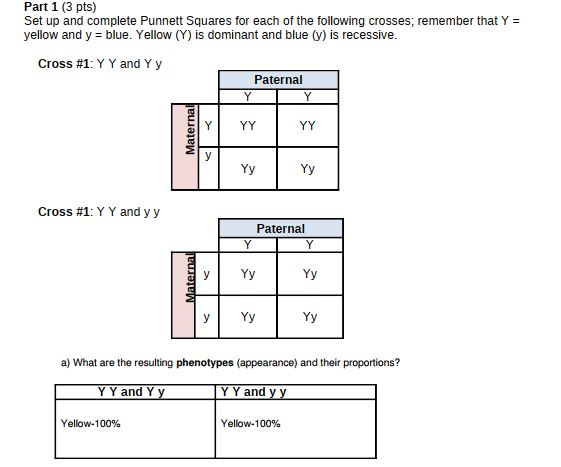Punnett Squares Week 6 Experiment Answer Sheet

WEEK 6 EXPERIMENT ANSWER SHEET SUMMARY OF ACTIVITIES FOR WEEK 6 EXPERIMENT ASSIGNMENT
• Lab 14 Experiment 1 – Punnett Square Crosses
• Week 6 Human Inherited Traits
Part 1
Set up and complete Punnett Squares for each of the following crosses; remember that Y = yellow and y = blue. Yellow (Y) is dominant and blue (y) is recessive.
a) What are the resulting phenotypes (appearance) and their proportions?
b) Are there any blue kernels (note that a kernel is an individual that is either YY, Yy or yy) in either cross? Why or why not; how can you tell?
Part 2
Set up and complete a Punnett Square for a cross of two of the F1 from the YY and yy cross. Be sure that you use the offspring
a) What are the genotypes and their percentages in the F2 generation?
b) What are their phenotypes and their percentages?
Part 3
Identify the four possible gametes produced by the following two individuals. Note that each gamete must consist of two alleles (Y or y and S or s)
Create a Punnett square using these two individuals (YYSs and YySs) and the gametes you identified above. If you are unsure how to complete a dihybrid cross, review the information under Lab 14 Introduction:
c) What are the possible F1 genotypes (these must now have four alleles) and their percentages?
d) Recall that SS and Ss individuals are smooth, while ss individuals are wrinkled and that YY and Yy individuals are yellow, while yy individuals are blue. What are the phenotypes of the resulting offspring and what is the ratio of these phenotypes?
Part 4
NOTE: You will not be using the Red and Green beads and you will not need to complete the Dihybrid Cross.
You have been provided with four bags of different colored beads. Pour 50 of the blue beads and yellow beads into beaker #1 and mix them around. Do not use the green and red beads
A. Monohybrid cross: Randomly (without looking) take out two beads from Beaker #1 Recall this beaker only has YELLOW (Y) or BLUE (y).
• This is the genotype of individual #1; record this information and do NOT put those beads back in the container.
• Repeat this for individual #2. These two individuals are your parents for the next generation.
Record the genotypes of the two individuals and set up a Punnett square. Determine the genotypes and phenotypes for this cross. Repeat this process four times (five times total).
Questions
a) Complete the Table below. Calculate how much genotypic variation you found in the randomly picked parents of your crosses. Meaning, what were the percentages of each possible genotype? How much genotypic variation did you in the offspring; what were the percentages of each possible genotype?
b) How much phenotypic variation? Meaning, what were the percentage of YELLOW and what was the percentage of BLUE phenotypes?
c) Is the ratio of observed offspring phenotypes the same as the ratio of predicted phenotypes (3 yellow : 1 blue)? Why or why not?
Yes because yellow is dominate and there were not as many blue beads picked.
d) What is the difference between a gene and an allele? Use your book glossary if necessary and be sure to provide a citation for the source you use
e) How might protein synthesis execute differently if a mutation occurs? Cite source(s) used
f) Organisms heterozygous for a recessive trait are often called carriers of that trait. What does that mean? Cite source(s) used.
g) In peas, green pods (GG, Gg) are dominant over yellow pods (gg). If a homozygous dominant plant is crossed with a homozygous recessive plant, what will be the phenotype of the F1 generation?
Part 5
The law of independent assortment allows for genetic recombination. The following equation can be used to determine the total number of possible genotype combinations for any particular number of genes:
2g = Number of possible genotype combinations (where g is the number of genes)
1 gene: 21 = 2 genotypes
2 genes: 22 = 4 genotypes
3 genes: 23 = 8 genotypes
a) Consider the following genotype: YySsTt. How many different gamete combinations can be produced?
b) Many traits (phenotypes), like eye color, are controlled by multiple genes. If eye color were controlled by the number of genes indicated below, how many possible genotype combinations would there be:
Week 6 Experiment: Human Inherited Traits
Read over the description of the Human Inherited Traits in the Week 6 Experiment instructions in our course and complete the table below. NOTE: For each of the traits in the table below, you must determine whether you exhibit them or not. In the data sheet, the
genotype and phenotype are YOURS based on your examination of yourself. If you exhibit a dominant trait, then remember that you may have more than one possible genotype! So, if you have the dominant characteristic, make sure that you list both of the genotypic
possibilities.
Questions
1. Which traits did you have that were dominant?
2. Which traits did you have that were recessive?
3. Define homozygous? Cite source(s) used.
4. Define heterozygous? Cite source(s) used.
5. Define genotype and phenotype? Cite source(s) used.
6. Which traits do you know for sure that you were homozygous?
Widow’s peak, tongue rolling, cleft chin, hitchhiker’s thumb, bent little finger and mid-digital
hair
Preview

NOTE: Please check the details before purchasing the document.

